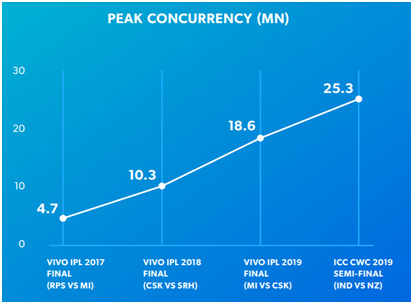MUMBAI: Technology changes swiftly. However, sometimes, the market receptiveness for these changes is even faster. Take for instance some of the revelatory insights thrown by the latest ‘India Watch’ report by Hotstar. Consider the fact that Technology changes swiftly. However, sometimes, the market receptiveness for these changes is even faster. Take for instance some of the revelatory insights thrown by the latest ‘India Watch’ report by Hotstar. Consider the fact that Lucknow, Pune and Patna consume more video data than Hyderabad, Bengaluru and Kolkata., Pune and Patna consume more video data than Hyderabad, Bengaluru and Kolkata. Or the fact that OTT is no longer a men’s club, as much as 45 per cent of total entertainment consumption at Hotstarcomes from women.
Similarly, Bihar and Bengal, two of India’s most poor states in per capita income, are leading the country when it comes to per capita data consumption and are much ahead of more industrialised and urban states like Maharashtra and Delhi. And, Kanpur and Kochi are ahead of Mumbai and Bengaluru when it comes to binge watching during late hours. The India Watch 2019 by Hotstarreport busts many such assumptions about the OTT market in India.
“Video entertainment ecosystems have rarely evolved fasterthan what we are witnessing in India. With affordable
smartphones and abundant access to data, the small screen isbecoming the preferred medium of entertainment for newconsumers. Thefuture is exciting – for consumers, for marketers, and forcontent platforms,” The Walt Disney Company APAC Chairman, Star & Disney India, Uday Shankar said in a foreword to the report.
The report also chronicles Hotstar’s amazing journey to becoming India’s largest premium streaming platform by viewership.Launched in 2015, Hotstar, with 400 Mn+ downloads, is already one of the most downloaded apps in India, registering 2X installs and 3X growth in consumption this year as compared to 2018. This growth catalyses from Hotstar's endeavors in taking digital video consumption to new frontiers, where non-metros are outstripping metros in terms of video consumption and regional content has grown to account for 40 per cent of overall content consumption.
The big Cricketgamble.
In September 2017, Star India (Hotstar’s erstwhile parent company) trumped Facebook, Reliance Jio, Sony and Bharti Airtel, and won broadcast rights for IPL for whopping Rs 16,347.50 crore for the next five years. That bet has largely paid off.
How sports streaming in general, and IPL in particular, have helped Hotstar in achieving subscriber growth not even imagined by other OTT platforms, is clear by live streaming viewership growth on Hotstar.
During IPL 2017, Hotstar recorded 4.5 million concurrent viewers. For IPL 2018, this number was 10.3 million. In 2019, Hotstar recorded 18.6 million concurrent viewers during IPL and 25.3 million concurrent viewers during ICC 2019 Cricket World Cup.
Live streaming sporting events like IPL has not only helped Hotstargrow its subscriber base, but such events also provide better advertising options on the platform. Brands like Swiggy and Coca Cola ran integrated ad campaigns on Cricketing and IPL themes during this IPL season and the report talks in detail about how these brands were able to leverage IPL popularity for their brand marketing.
Talking about advertising oppurtunities during live events, Shankar said: “Sharp customer insights and deeper customerengagement, when powered by enhanced technologicalcapabilities, will open new possibilities for marketers, whocan now run targeted marketing campaigns at scale duringlive events.”
During VIVO IPL 2019, 64 million viewers also participated in Watch ‘N Play, twice as many as last year.

The contribution of live streaming sporting events on Hotstar can be gauged from the fact that in 2019, as much as 42 % of all content consumed on Hotstar was sports related while 58 per cent was in the genres of entertainment and news (despite the surge during general elections).

Outdated gender stereotypes
any OTT audience measurement reports have underlined how the platform is heavily skewed towards male audience. The Ormax Media report, released last month in November, found that as much as 66 per cent OTT viewers are male. The India Watch report, however, throws interesting figures.
Not only are female viewers growing, at least on Hotstar, but there is a growing overlap of content choices among males and females on OTT space. In 2019, as much as 45 per cent of Hotstar viewership were women.

Besides, the report finds that video consumption by women on Hotstar increased by 3.2 X timesin 2019, outpacing the growth in video consumption among men.
Further, 40 per cent viewers of family drama shows on Hotstar are women. And men are more interested in mythology than women and 41 per cent of Game of Thrones viewers also watched Hindi family dramas.
Hotstar EVP & Chief Product Officer Varun Narang said, “The accelerated growth of the Indian video entertainment ecosystem has had an unprecedented impact on the consumer. Today, the Indian consumer enjoys a plethora of content to choose from, has moved beyond metro cities, and isn’t limited by gender or language. More importantly, this growing accessibility has opened doors to new thoughts and ideas that are shaping a stereotype-defying consumer.”
Regional leads the way
The report finds that more than 40 per cent video consumption came from regional content. Tamil, Telugu and Bengali are the top regional languages. In fact, Bigg Boss Tamil is the highest watched entertainment show having beaten all the Hindi TV Shows.
New ways to news
Another genre witnessing huge growth in video consumption is news. 2019, being the general election year. Hotstar recorded 10 times more video consumption in news genres in 2019 compared to last year. Further, 65 per cent of news consumption comes from people in the age group of 15-34.
The report is an important addition to the existing knowledge gap about OTT audience in India and will certainly provide new insights to marketers and content creators.






